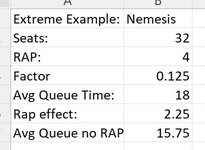BarryZola
TS Member
Controversial post incoming...
Maybe they could have certain days of the week when RAP is available, and on other days everyone has to queue as normal. Something like RAP is available on Mon/Wed/Fri/Sun and on the other days everyone would queue as normal. Also, on days where the RAP queues are long, after someone has waited for 50 minutes in a RAP queue, a manager would come along and revoke that person's RAP entitlement as they obviously CAN queue for long periods of time (unless being wheelchair bound etc stops them from using the normal queue and stuff like that).
Or you know, just have a strict timed service where ride hosts are consistent, strict and confident when enforcing such a thing.
Maybe they could have certain days of the week when RAP is available, and on other days everyone has to queue as normal. Something like RAP is available on Mon/Wed/Fri/Sun and on the other days everyone would queue as normal. Also, on days where the RAP queues are long, after someone has waited for 50 minutes in a RAP queue, a manager would come along and revoke that person's RAP entitlement as they obviously CAN queue for long periods of time (unless being wheelchair bound etc stops them from using the normal queue and stuff like that).
Or you know, just have a strict timed service where ride hosts are consistent, strict and confident when enforcing such a thing.


